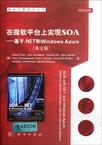在微软平台上实现SOA
2012-3
科学出版社
David Chou
876
周编写的《在微软平台上实现SOA——基于.NET和Windows Azure(英文版)》主要介绍在.NET和Windows
Azure平台上实现面向服务架构(SOA)的方法。首先综合介绍了在Microsoft平台上的现代服务技术进展,并进一步展现了这些技术提高应用和实现面向服务的潜在可能性;然后深入研究了Microsoft企业技术,如Windows
Azure、WCF、WPF等,以及涉及通用SOA设计模式和原则的工业技术与模型。书中附有大量的编码实例,详细分析了与云计算、编制、企业业务总线平台有关的各种技术架构和实现方式。
《在微软平台上实现SOA——基于.NET和Windows
Azure(英文版)》可供SOA领域的软件架构师、高级软件工程师、分析师、应用科研人员等参考学习。
作者:(美国)David Chou 等
Foreword by S. Somasegar
Foreword by David Chappell
CHAPTER 1: Introduction
CHAPTER 2: Case Study Background
PART I: FUNDAMENTALS
CHAPTER 3: SOA Fundamentals
CHAPTER 4: A Brief History of Legacy .NET Distributed
Technologies
CHAPTER 5: WCF Services
CHAPTER 6: WCF Extensions
CHAPTER 7: .NET Enterprise Services Technologies
CHAPTER 8: Cloud Services with Windows Azure
PART II:SERVICES AND SERVICE COMPOSITION
CHAPTER 9: Service-Orientation with .NET Part h Service Contracts
and Interoperability
CHAPTER 10: Service-Orientation with .NET Part Ih Coupling,
Abstraction,and Discoverability
CHAPTER 11 : Service.Orientation with .NET Part UI: Reusability and
Agnostic Service Models
CHAPTER 12: Service-Orientation with .NET Part IV: Service
Composition and Orchestration Basics
CHAPTER 13: Orchestration Patterns with WF
CHAPTER 14: Orchestration Patterns with BizTalk Server
PART III:INFRASTRUCTURE AND ARCHITECTURE
CHAPTER 15: Enterprise Service Bus with BizTalk Server and Windows
Azure
CHAPTER 16: Windows Azure Platform AppFabric Service Bus
CHAPTER 17: SOA Security with .NET and Windows Azure
CHAPTER 18: Service-Oriented Presentation Layers with .NET
CHAPTER 19: Service Performance Optimization
CHAPTER 20: SOA Metrics with BAM
PART IV: APPENDICES
APPENDIX A: Case Study Conclusion
APPENDIX B: Industry Standards Reference
APPENDIX C: Service-Orientation Principles Reference
APPENDIX D: SOA Design Patterns Reference
APPENDIX E: The Annotated SOA Manifesto
APPENDIX F: Additional Resources
About the Authors
About the Contributors
About the Foreword Contributors
Index
版权页:Documenting the intersection between the technology capabilities of a vendor productbased platform and the demands and requirements of the service-orientation design paradigm is always an interesting exercise. You find yourself exploring parts of the platform that go well beyond those labeled with the word "service" to discover strengths and weaknesses that have a direct bearing on the potential to realize the very specific goals associated with service-oriented computing.
《在微软平台上实现SOA:基于.Net和WindowsAzure(英文版)》是服务计算技术丛书之一。

希望对工作有好处。